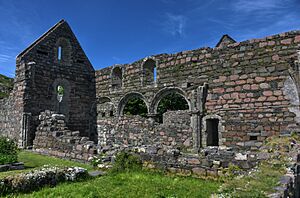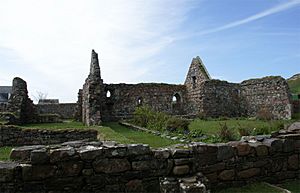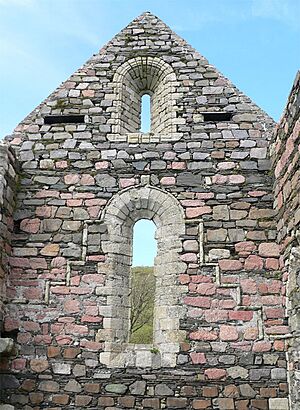Iona Nunnery facts for kids
The Iona Nunnery was a special home for Augustinian nuns on the island of Iona in Scotland. It was like a convent where nuns lived and prayed. This nunnery was built after a nearby monastery for monks was started in 1203.
A man named Ranald, who was the son of Somerled, helped set it up. Ranald's sister, Bethóc, became the very first leader, called a prioress. Today, you can still see the peaceful ruins of the nunnery. They are next to Iona's main village, Baile Mor. These ruins are the best-preserved remains of a medieval nunnery in all of Scotland. After a big change in Scotland called the Scottish Reformation, the nunnery was closed down and became a ruin.
A Look Back: History of the Nunnery
The Iona Nunnery was founded after the Benedictine monastery was built in 1203. This monastery was started by Raghnall mac Somhairle, also known as Ranald. His sister, Bethóc, became the first prioress, leading the nuns.
This nunnery was one of only three Augustinian convents for women in Scotland. The other two were St. Leonards Nunnery near Perth and Teampull na Trionaid in North Uist.
At the museum in the nearby Iona Abbey, you can see part of a headstone. It belonged to Anna MacLean, who was a prioress of the nunnery. She passed away in 1543.
People have worked to restore parts of the nunnery ruins. This important work happened in 1923 and again in 1993.
Building the Nunnery: How it Looked
The Iona Nunnery was built in a style similar to buildings in Ireland. The main church building has three sections. There is also a passage on the north side. A small chapel is located on the east side of this passage.
The cloister, which is an open courtyard surrounded by covered walkways, measures about 14 meters square. It was actually a bit smaller when it was first built. The east part of the building had three rooms on the ground floor. Above these rooms was the dormitory, where the nuns slept.
The south part of the building held the refectory. This was the dining hall where the nuns ate their meals. In the 1500s, another floor was added to this area. The west part of the building is now below the modern road. It was probably used as a place for guests to stay.
Who Looks After the Nunnery Today?
The Iona Nunnery is currently cared for by Historic Environment Scotland. This organization helps protect important historical places in Scotland. The nunnery is also a scheduled monument. This means it is a nationally important archaeological site or historic building. It is protected by law to make sure it is preserved for the future.




